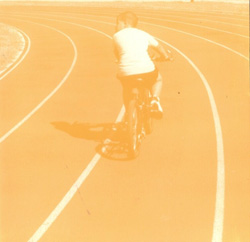
An open act of detournement (or diversion), The Architecture of the Incidental felicitously finds aural residues - traces of transience and our growing experience of a drifting, sightless world - and, through an array of aleatory processes, endeavors to deflect them from their function. The work leans heavily on the aged body of The Situationists - specifically that of Guy Debord. In keeping with his vision, space is seen as having undergone a double reduction: first a heterogeneous space, with all its excrescences and such, is transformed into the homogeneous space of Euclid, where the individual enjoys a calcined life; finally, through further alteration, this space is cleaved such that it consists now in only two dimensional representations. No longer opaque and concrete, it's abstract and transparent; not space, but it's (truly full) image, an image that gives everything and is to be looked at passively, rather than lived directly, giving off an ineffectual decorative feeling.
In its depths, duplications, echoes, and reverberations, it's redundancies, and doublings-up, which engender - and are themselves engendered by - the most peculiar of contrasts, this album - consisting of tracks from artists such as Francisco Lopez, John Hudak, Pat Courtney, and Chop Shop, to name a few - makes an ardent effort to not only edify, but to reinvigorate and restore a certain sense of space, to rip the notion away from its image and, in so doing, to open up a spawning ground in which a certain energy is able to feed off the differences - however slight - that ensue.
It's successful in that it ferrets out the illusion of transparency. Even in the opening few pieces, which in their arrangement and sequencing represent the discs most abstract and uniform moments - moments which, at least in part, try to hear for the listener - reveal that such standard sonic architecture still vibrates with detail. The selection from Sean Meehan isn't merely a distillation of the sounding properties of an environments detritus; without turning it into an overtly aesthetisized object, clean and appealing in its ambiance, the space enters into a sort of in-between zone where anachronistic elements appear and disappear, leaving traces that accrue, alter the texture, and in turn the sense of time.
The latter finds itself particularly altered by the transition from the pieces put forward by Geoff Dugan and Gen Ken Montgomery to that of If Bwana. Whereas the former two push forward the instigation (rather than designation) techniques that preceded them, focusing on higher, more abrasive frequencies, challenging in an almost surreal manner the limits of endurance, in a surprising and quite effective manner If Bwana trim all of this away and find a place to breath fluidity back into time like a mothers cord pulsing life into the womb. In fact, however one runs up against it, the slice of time presented, afforded by a vast, open space, with a calm, coherent, and spontaneous sequence of natural events, in stark contrast to the plenitude of destructive forces on display elsewhere, is something of an exemplary experience. Make of its theoretical underpinnings what you will, the effortful dialectic between ungiving materials and musical decisions dictated by studied and alert ears jars open just enough clefts in its subject-matter to allow one to conceive and consider space in their ever-heightening contiguity and contamination.
Comments and Feedback:



More Recent Reviews, Articles, and Interviews @ The Squid's Ear...


|

